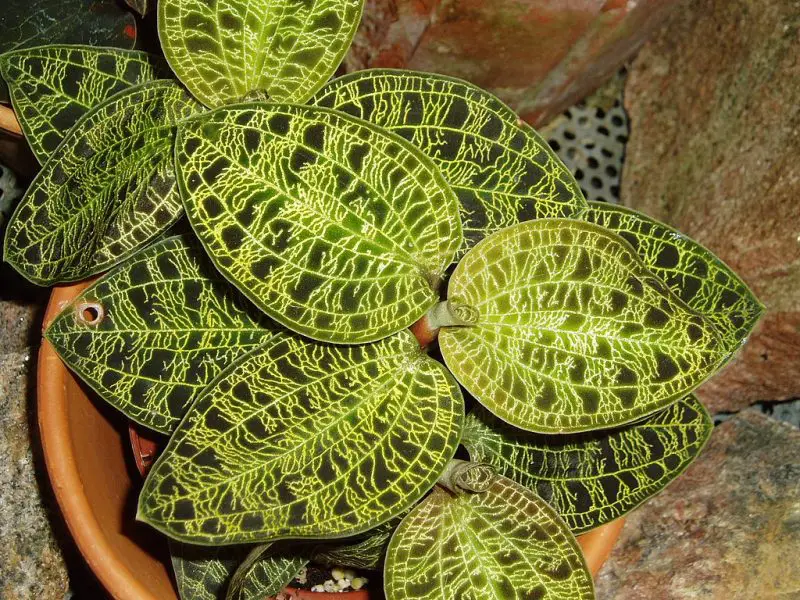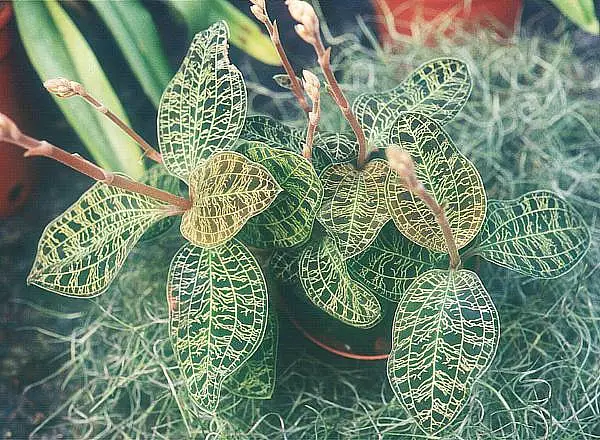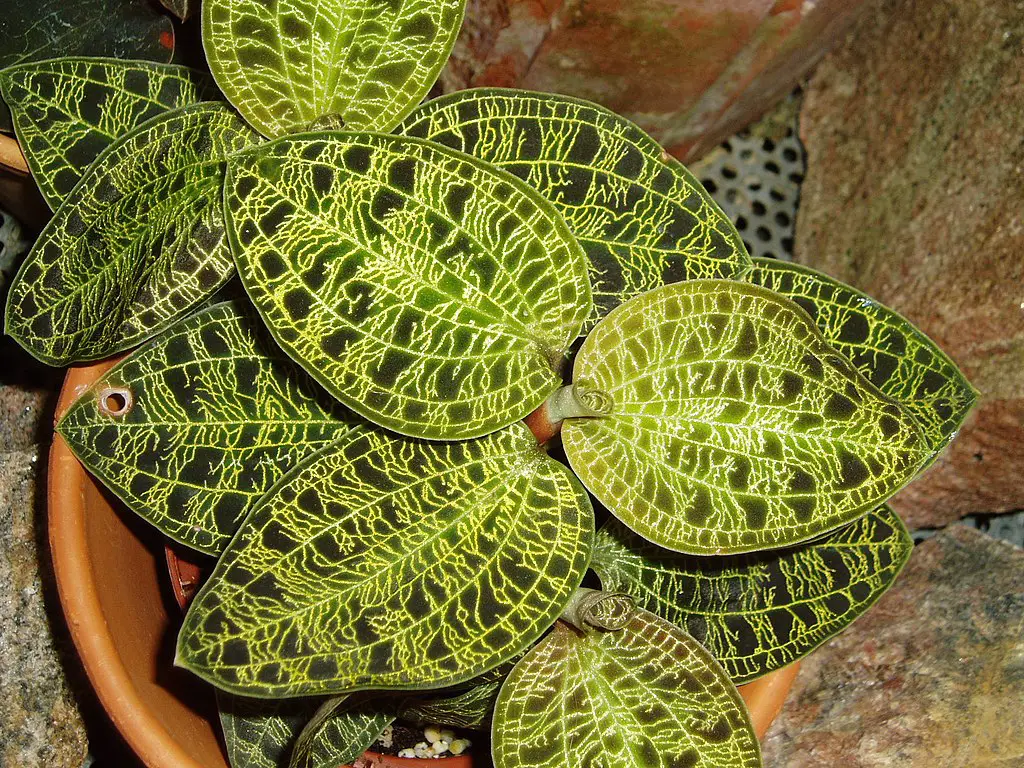
Unlock the secrets of Macodes Petola Jewel Orchid Care with our expert tips on light, humidity, watering, and more. Discover how to keep your orchid thriving!
Macodes Petola Jewel Orchid Care Key Takeaways:
- Macodes Petola Jewel Orchid Care involves providing bright, indirect light, maintaining high humidity levels (50-70%), ensure the soil is consistently moist but well draining.
- Fertilize weekly during the growing season with a diluted, balanced fertilizer.
- Repot annually and keep an eye out for pests. With proper care, your jewel orchid will flourish, showcasing its stunning foliage.
Welcome to the world of Macodes Petola Jewel Orchid Care! If you’re captivated by the stunning foliage and intricate veining of this exquisite plant, you’ve come to the right place.
In this guide, we’ll share essential tips and tricks to help you nurture your jewel orchid into a thriving, vibrant centerpiece.
Let’s embark on this exciting journey together!
Macodes Petola Jewel Orchid Care: A Comprehensive Guide
The Macodes Petola, commonly known as the Jewel Orchid, is a captivating houseplant known for its stunning foliage rather than its flowers.
The leaves of this orchid are a true spectacle, with intricate veining patterns that resemble lightning bolts or intricate networks of gold or silver.
These patterns are set against a rich, dark green background, creating a striking contrast that makes the plant a standout addition to any indoor garden.
Importance of Proper Care
Proper care is crucial for maintaining the beauty and health of the Macodes Petola.
This orchid has specific requirements regarding light, humidity, temperature, and watering, which, if met, will ensure the plant thrives and continues to display its mesmerizing foliage.
Neglecting its care needs can lead to stress, disease, or even the loss of the plant.
Therefore, understanding and providing the right conditions is key to enjoying the full beauty of this jewel orchid.
Overview of Macodes Petola

- Botanical Name: Macodes Petola
- Family: Orchidaceae
- Origin: The Macodes Petola is native to Southeast Asia, including regions such as Borneo, Sumatra, the Philippines, and Malaysia. Its natural habitat is the humid, shaded forest floors, which provides clues to its care requirements in a home setting.
- Distinctive Features: The most notable feature of the Macodes Petola is its foliage. The leaves are typically dark green with a velvety texture and are adorned with intricate, sparkling veins. The patterns on the leaves are unique to each plant, making each Macodes Petola a one-of-a-kind specimen. While this orchid does produce flowers, they are small and not as visually striking as the leaves. The focus with this plant is truly on its jewel-like foliage.
Macodes petola (previously Neottia petola)[1] is a species of jewel orchid endemic to Southeast Asia including in Malaysia, New Guinea, Vanuatu, the Philippines and Sumatra.
Flowers from this species are small, with red-brown petals with a yellow edge and white lip and appear in the winter months.
Unlike the flower, the foliage on this plant is ornate and renders this plant of interest to botanical collectors. Wikipedia
In the following sections, we’ll delve into the specific care requirements for the Macodes Petola, covering aspects such as lighting, watering, humidity, temperature, soil, and more.
By providing the right environment and attention, you can ensure your Jewel Orchid remains a vibrant and enchanting feature in your indoor garden.
Botanical Name: Macodes Petola
The Macodes Petola, commonly known as the Jewel Orchid, is a species within the Orchidaceae family.
Its botanical name, Macodes Petola, distinguishes it from other orchids and highlights its unique characteristics.
Family: Orchidaceae
The Orchidaceae family, to which the Macodes Petola belongs, is a diverse and widespread family of flowering plants.
Orchids are known for their beautiful flowers and unique adaptations.
The Macodes Petola, however, is particularly prized for its stunning foliage rather than its flowers.
Origin: Southeast Asia (Borneo, Sumatra, the Philippines, Malaysia)
Native to the humid, tropical regions of Southeast Asia, the Macodes Petola thrives in environments similar to the forest floors of Borneo, Sumatra, the Philippines, and Malaysia.
These areas provide the warm, moist conditions that are ideal for the growth of this orchid.
Distinctive Features: Beautiful foliage, striking leaves, and unique veining patterns
The most distinctive feature of the Macodes Petola is its foliage.
The leaves are typically dark green with a velvety texture, adorned with intricate veins that shimmer in the light.
These veins can appear in various colors, including gold, silver, and copper, creating a striking contrast against the dark background of the leaves.
This unique veining pattern is what gives the Jewel Orchid its name and makes it a sought-after plant for collectors and enthusiasts.
Ideal Growing Conditions
To thrive, the Macodes Petola requires conditions that mimic its natural habitat:
- Light: Bright, indirect light is ideal. Avoid direct sunlight, which can scorch the leaves. A north-facing window or a spot that receives filtered light is perfect.
- Temperature: Warm temperatures between 65-85°F (18-29°C) during the day and slightly cooler temperatures at night are preferred. Avoid exposure to temperatures below 60°F (15°C).
- Humidity: High humidity levels of 50-70% are essential. Use a humidifier, place a tray of water near the plant, or group plants together to increase humidity. Avoid misting the leaves directly to prevent fungal diseases.
- Soil: A well-draining, airy potting mix is crucial. A mix of sphagnum moss, perlite, and bark works well. The soil should retain moisture without becoming waterlogged.
- Watering: Keep the soil consistently moist but not soggy. Allow the top inch of soil to dry out slightly before watering again. Overwatering can lead to root rot.
- Fertilization: During the growing season (spring and summer), fertilize monthly with a balanced, diluted fertilizer. Reduce fertilization in the fall and winter when growth slows down.
By providing the Macodes Petola with these ideal growing conditions, you can ensure that your Jewel Orchid remains healthy and continues to display its stunning foliage.
Fertilization and Feeding
To ensure your Macodes Petola thrives, it’s important to provide it with the right nutrients:
- Fertilizer Type: Use a balanced or nitrogen-rich fertilizer. Balanced fertilizers have equal parts nitrogen, phosphorus, and potassium (e.g., 10-10-10), while nitrogen-rich fertilizers have a higher first number (e.g., 24-8-16).
- Dilution: Dilute the fertilizer to 1/4 or 1/8 of the strength recommended on the package. This prevents over-fertilization, which can lead to salt buildup and root damage.
- Frequency: Apply the diluted fertilizer weekly during the growing season, which is typically spring and summer. Reduce or stop fertilizing in the fall and winter when the plant’s growth slows down.
- Over-fertilization: Be cautious not to over-fertilize, as this can harm the plant. Signs of over-fertilization include brown leaf tips, wilting, and stunted growth.
Propagation Methods
Macodes Petola can be propagated using various methods:
- Stem Cuttings: Take healthy tip cuttings with at least 3 leaf nodes. Plant these cuttings in moist sphagnum moss and maintain high humidity to encourage root growth. This method is ideal for the spring or early summer.
- Rhizome Division: During repotting, you can divide the rhizome into sections, each with at least one growth point (leaf or bud). Plant each division in its own pot with the appropriate soil mix.
- Air Layering: This method is less common for Macodes Petola but can be effective for larger plants. It involves wounding a part of the stem and wrapping it with moist moss until roots develop, after which the new plant can be separated from the parent.
Potting and Repotting
Regular potting and repotting are crucial for the health of your Macodes Petola:
- Frequency: Repot annually, especially if you’re using sphagnum moss, which can break down and increase the risk of fungal infections.
- Pot Selection: Choose pots with good drainage to prevent waterlogging. The pot size should be slightly larger than the root ball.
- Soil Packing: Avoid packing the soil too tightly, as this can impede drainage and airflow to the roots.
- Handling: Be gentle during repotting to avoid damaging the delicate stems and roots.
Common Pests and Diseases
Keep an eye out for common pests and diseases that can affect Macodes Petola:
- Pests: Aphids, spider mites, and mealybugs can infest the plant. Treat with neem oil or horticultural sprays to control these pests.
- Root Rot: Prevent root rot by ensuring well-draining soil and avoiding overwatering. Signs of root rot include yellowing leaves, wilting, and a mushy base.
- Leaf Diseases: Bacterial and fungal leaf diseases can occur, especially in high humidity. Keep leaves dry and provide good air circulation to prevent these issues.
By following these guidelines, you can ensure your Macodes Petola remains healthy and continues to display its stunning foliage.
Macodes Petola Jewel Orchid Care FAQs
Q: What are the signs of overwatering in Macodes Petola?
A: Signs of overwatering include yellowing leaves, a mushy base, and root rot. You may also notice a stagnant, musty smell from the soil.
Q: How can I increase humidity for my Macodes Petola?
A: You can increase humidity by using a humidifier, placing a tray of water near the plant, or grouping plants together. Avoid misting the leaves directly to prevent fungal diseases.
Q: What should I do if the leaves of my Macodes Petola start to fade?
A: Fading leaves can be a sign of too much direct sunlight. Move your plant to a location with bright, indirect light. If the fading persists, check for other stress factors such as overwatering or nutrient deficiencies.
Q: How often should I water my Macodes Petola?
A: Water your Macodes Petola when the top inch of soil feels dry to the touch. The frequency will depend on factors such as temperature, humidity, and light levels.
Q: Can I use tap water to water my Macodes Petola?
A: It’s best to use distilled or rainwater, as tap water may contain minerals and chemicals that can build up in the soil and harm the plant. If you must use tap water, let it sit for 24 hours to allow chlorine to evaporate.
Q: How do I know if my Macodes Petola is getting enough light?
A: If your plant is growing well and the leaves have vibrant colors and patterns, it’s likely getting enough light. If the plant becomes leggy or the leaves lose their luster, it may need more light.
Q: Can Macodes Petola be grown outdoors?
A: Macodes Petola can be grown outdoors in regions with a tropical climate that mimics its natural habitat. In temperate regions, it’s best to grow it indoors or in a greenhouse.
Macodes Petola Jewel Orchid Care Conclusion
Caring for Macodes Petola requires attention to its specific needs, such as high humidity, bright indirect light, and consistent moisture.
By addressing common concerns and providing the right environment, you can enjoy the stunning beauty of this jewel orchid for years to come.
Key Care Tips for Macodes Petola: Recap
- Light: Provide bright, indirect light. Avoid direct sunlight, which can scorch the leaves.
- Temperature: Maintain temperatures between 65-85°F (18-29°C) during the day and slightly cooler at night. Avoid temperatures below 60°F (15°C).
- Humidity: Keep humidity levels high, between 50-70%. Use a humidifier or place a tray of water near the plant to increase humidity. Avoid misting the leaves directly.
- Watering: Water when the top inch of soil feels dry. Ensure the soil is consistently moist but not waterlogged. Reduce watering in cooler months.
- Soil: Use a well-draining, airy potting mix. A mix of sphagnum moss, perlite, and bark works well.
- Fertilization: Fertilize weekly during the growing season with a balanced or nitrogen-rich fertilizer diluted to 1/4 or 1/8 strength. Reduce fertilization in the fall and winter.
- Repotting: Repot annually, especially if using sphagnum moss, to prevent fungal infections. Choose pots with good drainage and avoid packing the soil too tightly.
- Pests and Diseases: Watch for aphids, spider mites, and mealybugs. Treat with neem oil or horticultural sprays. Prevent root rot by ensuring well-draining soil and avoiding overwatering. Keep leaves dry and provide good air circulation to prevent bacterial and fungal leaf diseases.
Read more: Are Orchids Hard To Take Care Of? Easy Growth Formula
Learn more about different orchid types
Learn how to care for Encyclia Orchids
Resources
For those interested in delving deeper into Macodes Petola care, here are some authoritative sources:
- Smart Garden Guide: A detailed guide covering various aspects of Macodes Petola care, including light, watering, humidity, and more.
- Gustaf’s Greenery: An expert care guide that provides insights into the features, care, and propagation of Macodes Petola.
- Plantophiles: A comprehensive guide that covers the care, propagation, and common problems associated with Macodes Petola.
This post contains affiliate links.

